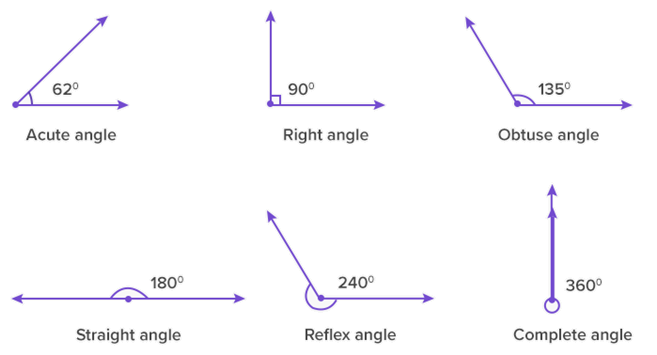CLASS-6
TYPES OF ANGLE
TYPES OF ANGLE -
There are several types of angles in geometry, classified based on their measure or the relationships between their sides and angles. Here are some common types of angles:
- Acute Angle:- An acute angle is an angle that measures less than 90 degrees. In other words, it's a "small" angle.
- Right Angle:- A right angle measures exactly 90 degrees. It forms a perfect "L" shape.
- Obtuse Angle:- An obtuse angle is an angle that measures more than 90 degrees but less than 180 degrees. It's larger than a right angle but smaller than a straight angle.
- Straight Angle:- A straight angle measures exactly 180 degrees. It forms a straight line.
- Reflex Angle:- A reflex angle is an angle that measures more than 180 degrees but less than 360 degrees. It's greater than a straight angle.
- Full Angle (Complete Angle):- A full angle, also known as a complete angle, measures 360 degrees. It represents a complete rotation around a point.
- Complementary Angles:- Two angles are complementary if the sum of their measures is 90 degrees. In other words, one angle is the complement of the other.
- Supplementary Angles:- Two angles are supplementary if the sum of their measures is 180 degrees. In this case, one angle is the supplement of the other.

9. Vertical Angles:- Vertical angles are a pair of non-adjacent angles formed by the intersection of two straight lines. They have equal measures.
10. Adjacent Angles:- Adjacent angles share a common vertex and a common side, but they do not overlap. They are typically found side by side.
11. Interior Angles:- Interior angles are the angles formed inside a polygon. For a polygon with n sides, it has n interior angles.
12. Exterior Angles:- Exterior angles are the angles formed outside a polygon when one side is extended. The exterior angle is supplementary to the interior angle.
13. Corresponding Angles:- Corresponding angles are formed when a transversal intersects two parallel lines. They are found in corresponding positions on the parallel lines and are equal in measure.
14. Alternate Interior Angles:- Alternate interior angles are formed when a transversal intersects two parallel lines, and they are on opposite sides of the transversal between the two lines. They are equal in measure.
15. Alternate Exterior Angles:- Similar to alternate interior angles, alternate exterior angles are formed when a transversal intersects two parallel lines, but they are outside the two lines and on opposite sides of the transversal. They are equal in measure.
These types of angles play a fundamental role in geometry and are used to describe and analyze the properties of geometric shapes, lines, and angles. Understanding their relationships and properties is important in various mathematical and architectural applications.